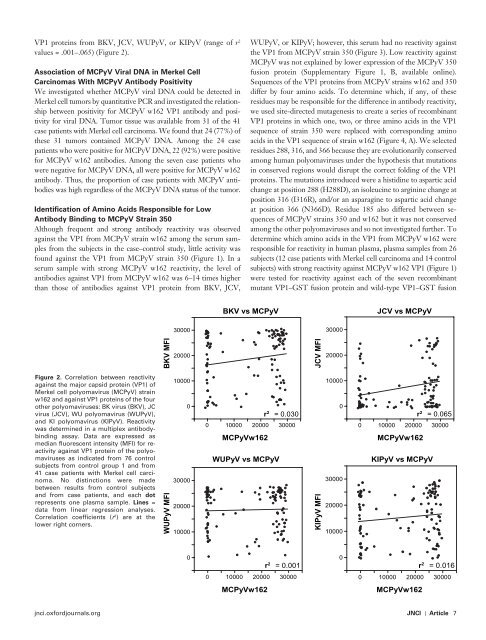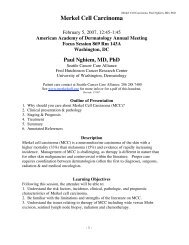Association of Merkel Cell Polyomavirus â Specific Antibodies With ...
Association of Merkel Cell Polyomavirus â Specific Antibodies With ...
Association of Merkel Cell Polyomavirus â Specific Antibodies With ...
Create successful ePaper yourself
Turn your PDF publications into a flip-book with our unique Google optimized e-Paper software.
WUPyV MFI<br />
KIPyV MFI<br />
BKV MFI<br />
JCV MFI<br />
VP1 proteins from BKV, JCV, WUPyV, or KIPyV (range <strong>of</strong> r 2<br />
values = .001 – .065) ( Figure 2 ).<br />
<strong>Association</strong> <strong>of</strong> MCPyV Viral DNA in <strong>Merkel</strong> <strong>Cell</strong><br />
Carcinomas <strong>With</strong> MCPyV Antibody Positivity<br />
We investigated whether MCPyV viral DNA could be detected in<br />
<strong>Merkel</strong> cell tumors by quantitative PCR and investigated the relationship<br />
between positivity for MCPyV w162 VP1 antibody and positivity<br />
for viral DNA. Tumor tissue was available from 31 <strong>of</strong> the 41<br />
case patients with <strong>Merkel</strong> cell carcinoma. We found that 24 (77%) <strong>of</strong><br />
these 31 tumors contained MCPyV DNA. Among the 24 case<br />
patients who were positive for MCPyV DNA, 22 (92%) were positive<br />
for MCPyV w162 antibodies. Among the seven case patients who<br />
were negative for MCPyV DNA, all were positive for MCPyV w162<br />
antibody. Thus, the proportion <strong>of</strong> case patients with MCPyV antibodies<br />
was high regardless <strong>of</strong> the MCPyV DNA status <strong>of</strong> the tumor.<br />
Identification <strong>of</strong> Amino Acids Responsible for Low<br />
Antibody Binding to MCPyV Strain 350<br />
Although frequent and strong antibody reactivity was observed<br />
against the VP1 from MCPyV strain w162 among the serum samples<br />
from the subjects in the case – control study, little activity was<br />
found against the VP1 from MCPyV strain 350 ( Figure 1 ). In a<br />
serum sample with strong MCPyV w162 reactivity, the level <strong>of</strong><br />
antibodies against VP1 from MCPyV w162 was 6 – 14 times higher<br />
than those <strong>of</strong> antibodies against VP1 protein from BKV, JCV,<br />
WUPyV, or KIPyV; however, this serum had no reactivity against<br />
the VP1 from MCPyV strain 350 ( Figure 3 ). Low reactivity against<br />
MCPyV was not explained by lower expression <strong>of</strong> the MCPyV 350<br />
fusion protein ( Supplementary Figure 1 , B , available online).<br />
Sequences <strong>of</strong> the VP1 proteins from MCPyV strains w162 and 350<br />
differ by four amino acids. To determine which, if any, <strong>of</strong> these<br />
residues may be responsible for the difference in antibody reactivity,<br />
we used site-directed mutagenesis to create a series <strong>of</strong> recombinant<br />
VP1 proteins in which one, two, or three amino acids in the VP1<br />
sequence <strong>of</strong> strain 350 were replaced with corresponding amino<br />
acids in the VP1 sequence <strong>of</strong> strain w162 ( Figure 4, A ). We selected<br />
residues 288, 316, and 366 because they are evolutionarily conserved<br />
among human polyomaviruses under the hypothesis that mutations<br />
in conserved regions would disrupt the correct folding <strong>of</strong> the VP1<br />
proteins. The mutations introduced were a histidine to aspartic acid<br />
change at position 288 (H288D), an isoleucine to arginine change at<br />
position 316 (I316R), and/or an asparagine to aspartic acid change<br />
at position 366 (N366D). Residue 185 also differed between sequences<br />
<strong>of</strong> MCPyV strains 350 and w162 but it was not conserved<br />
among the other polyomaviruses and so not investigated further. To<br />
determine which amino acids in the VP1 from MCPyV w162 were<br />
responsible for reactivity in human plasma, plasma samples from 26<br />
subjects (12 case patients with <strong>Merkel</strong> cell carcinoma and 14 control<br />
subjects) with strong reactivity against MCPyV w162 VP1 ( Figure 1 )<br />
were tested for reactivity against each <strong>of</strong> the seven recombinant<br />
mutant VP1 – GST fusion protein and wild-type VP1 – GST fusion<br />
BKV vs MCPyV<br />
JCV vs MCPyV<br />
30000<br />
30000<br />
20000<br />
20000<br />
Figure 2 . Correlation between reactivity<br />
against the major capsid protein (VP1) <strong>of</strong><br />
<strong>Merkel</strong> cell polyomavirus (MCPyV) strain<br />
w162 and against VP1 proteins <strong>of</strong> the four<br />
other polyomaviruses: BK virus (BKV), JC<br />
virus (JCV), WU polyomavirus (WUPyV),<br />
and KI polyomavirus (KIPyV). Reactivity<br />
was determined in a multiplex antibodybinding<br />
assay. Data are expressed as<br />
median fluorescent intensity (MFI) for reactivity<br />
against VP1 protein <strong>of</strong> the polyomaviruses<br />
as indicated from 76 control<br />
subjects from control group 1 and from<br />
41 case patients with <strong>Merkel</strong> cell carcinoma.<br />
No distinctions were made<br />
between results from control subjects<br />
and from case patients, and each dot<br />
represents one plasma sample. Lines =<br />
data from linear regression analyses.<br />
Correlation coefficients ( r 2 ) are at the<br />
lower right corners.<br />
10000<br />
0<br />
30000<br />
20000<br />
10000<br />
r 2 = 0.030<br />
0 10000 20000 30000<br />
MCPyVw162<br />
WUPyV vs MCPyV<br />
10000<br />
0<br />
30000<br />
20000<br />
10000<br />
r 2 = 0.065<br />
0 10000 20000 30000<br />
MCPyVw162<br />
KIPyV vs MCPyV<br />
0<br />
r 2 = 0.001<br />
0<br />
r 2 = 0.016<br />
0 10000 20000 30000<br />
0 10000 20000 30000<br />
MCPyVw162<br />
MCPyVw162<br />
jnci.oxfordjournals.org JNCI | Article 7



